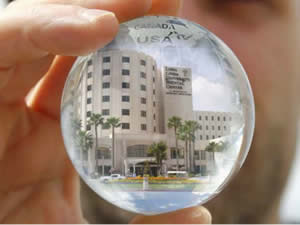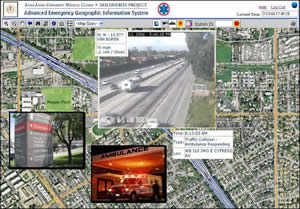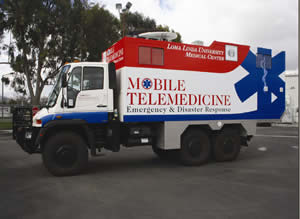By Ruthita Fike, MA
Chief Executive Officer, Loma Linda University Medical Center
Geography is more than just a place on a map with distinctive topographic features. It fundamentally influences and connects our many cultures, societies, and ways of life.
| |

GIS helps Loma Linda University Medical Center and Loma Linda University fulfill a mission to improve health care delivery, refine research initiatives, and educate the next generation of health care professionals. |
Geography also plays a critical role in improving health care. At Southern California's Loma Linda University Medical Center (LLUMC), we're embracing the emerging discipline of health geoinformatics, which uses innovative scientific and geospatial technology to investigate health issues.
A multifaceted collaboration involving the use of geographic information system (GIS) technology is changing how LLUMC and the associated health sciences university, Loma Linda University (LLU), relate to the world. And because of the almost limitless possibilities of GIS, we have been able to create a better future for those whose lives we touch.
Our long-term collaboration with Esri, the GIS software company headquartered in nearby Redlands, has had far-reaching outcomes at every level of our organization. It's helping us fulfill our mission to improve health care delivery, refine research initiatives, and educate the next generation of health care professionals. We are teaching them health geoinformatics. They will learn how to collect, analyze, and share information to provide optimal solutions to critical public health issues around the globe such as public health emergency response.
Because of our work with GIS, we see the world differently. We are living proof that better information makes for better business decisions.
The Medical Center's Heritage and Mission
LLUMC is an academic medical center, one of only 125 in the United States.
We are strategically located in what's known as the Inland Empire, one of the fastest-growing regions in the country. With nearly four million residents, the Inland Empire is larger than 24 of the 50 states.
Loma Linda University was founded in 1905 as a Seventh-Day Adventist educational health sciences institution. By 2006, it had grown to 3,400 students in the schools of medicine, dentistry, and pharmacy and departments of nursing, public health, allied health, science, and technology. Through Adventist Health International, Loma Linda provides assistance in governance, accounting, and fund-raising for 32 hospitals and 52 clinics in 13 countries. For instance, Loma Linda University has been managing Wazir Akbar Khan Hospital in Kabul, Afghanistan, since 2005, through a U.S. AID grant and at the request of the Afghanistan government. LLU also manages Gimbie Adventist Hospital in Ethiopia and is a consultant to the Chinese government at Sir Run Run Shaw Hospital in Hangzhou.
We are proud of our community and our heritage as well as our students, faculty, and alumni. We're also very proud of the fact that the founder of Esri, Mr. Jack Dangermond, was born at LLUMC. For a short time, our campus housed Esri's offices before their world headquarters were developed in Redlands, just a few miles from the LLU campus. So the roots of our partnership are deep, and we are grateful for them.
We comprise four hospitals: the University Hospital; Children's Hospital; the East Campus hospital, which provides rehabilitation, orthopaedic, and neurosciences services; and the Behavioral Medicine Center. About 750 physicians partner with us in delivering care. Our 7,000 employees skillfully handle hundreds of thousands of patient visits per year.
Nearly 600 medical residents and fellows are training at Loma Linda at any given time. Research at Loma Linda has led to a number of medical breakthroughs and clinical firsts including
- The Judkins technique of coronary arteriography, a forerunner of angioplasty.
- Pioneering work in endoscopic surgery.
- The first infant heart transplant program.
- Development of the world's first hospital-based proton treatment center. The center provides highly precise proton radiation treatments for 125 patients each day with a variety of cancers and other diseases, and it also does research into the use of proton radiation to treat additional forms of cancer and other diseases.
GIS Applications at Loma Linda
There are several areas that demonstrate the value of increasing geographic literacy in our organization. GIS technology has added an entirely new dimension to the clinical, academic, and research programs at Loma Linda University on many levels. We are applying GIS to real-life scenarios that are making a difference in thousands of lives.
Clinical
| |

Loma Linda University Medical Center's Web-based Advanced Emergency Geographic Information System (AEGIS) receives continuous data feeds and photos that show, for example, in close to real time, where air ambulances have been dispatched and which freeways are congested. A Mobile Intensive Care Nurse working on a computer will be able to see that information displayed on a digital map on a 40-inch LCD monitor. |
LLUMC operates the only Level I trauma center in a vast geographic region. We are also situated in one of the most earthquake-prone areas in the country. As the largest hospital in the region, we have a social responsibility to be prepared to respond to emergencies of every type.
In emergency response, every second counts. Linking emergency resources with victims is fundamentally a geographic challenge. A big part of that challenge is the fragmentation of emergency services and lack of a central communications clearinghouse. Loma Linda wanted to build a system that could be accessed by the community, allowing all emergency resources to be fully coordinated.
In 2005, Loma Linda approached Esri about collaborating in the Discoveries project, which is a congressionally sponsored partnership with the U.S. Department of Defense. The goal was to develop a Web-based situational awareness geographic information system for use in emergency medical services. Such a system would monitor and map the location and status of emergencies, locate victims and emergency response personnel, and track other factors that can impact emergency response. The result of this collaboration is the Advanced Emergency Geographic Information System (AEGIS).
Using GIS, AEGIS graphically maps the real-time location of an emergency and its victims as well as emergency response assets. It maps where ambulances, rescue helicopters, and other emergency vehicles are and the locations of all fire departments, rescue workers, and law enforcement officers. By glancing at the screen, emergency personnel can determine which hospital emergency rooms in San Bernardino and Riverside counties can accept more ambulances and which ones are at capacity. AEGIS overlays traffic congestion and accidents on freeways to plot the fastest routes to area trauma centers. In many cases, this reduces response and transport time from a half-hour or more to just minutes at a time when minutes mean lives saved. All emergency responders in Southern California can access AEGIS via the Web or by using a basic cell phone or an in-vehicle unit, so there is literally coverage everywhere.
A specially equipped mobile telemedicine command center serves in the field as the hub of rescue efforts.
Academic
At Loma Linda, we have come to appreciate how GIS technology can be used to improve health and quality of life. In public health, for example, it provides a means to collect and analyze information on how natural resources, the environment, and human diseases interact. As a health sciences university, we recognize that geoinformatics can help us provide future health professionals with a valuable tool to understand the impact of our environment on human health.
Health geoinformatics is a relatively new discipline that uses a combination of GIS technologies to investigate health issues. In this area, it has helped by mapping the adolescent pregnancy rates for each high school attendance area in southwest San Bernardino County. This makes it possible to identify which areas may need additional resources to address teen pregnancy.
GIS can also increase efficiency in public health services. Local public health agencies are often organized geographically. It is possible that a home or business on one side of a street can be in one agency's service area, while the building across the street belongs in another service area. GIS eliminates confusion. When an agency receives a complaint-say an environmental complaint-the street address is processed through a GIS program that standardizes the address in conformance with U.S. Postal Service standards. It even corrects spelling errors and verifies the existence of the address. The complaint is then automatically assigned to the appropriate service area, which eliminates possible confusion over jurisdiction.
Another example: Say a non-English-speaking, foreign-born person entering the United States is identified as having tuberculosis (TB) as well as a severe heart problem that requires medication. A TB outreach worker can use a GIS health care access map to identify the nearest cardiologist who speaks the same language as the patient. At the same time, using GIS technology, the TB outreach worker can also produce a public transportation map, printed both in English and in the patient's language, that shows the patient how to travel to the physician's office for treatment.
In partnership with Esri, Loma Linda University has greatly advanced the field of health geoinformatics. This partnership has resulted in three health geoinformatics firsts:
- The school's faculty designed and taught the first graduate-level GIS course offered at an American school of public health.
- LLU launched the country's first health geographics bachelor's degree. Today, undergraduate students can pursue a Bachelor of Science in Public Health (B.S.P.H.) in Health Geographics and Biomedical Data Management. Other tracks offered are GIS for Environmental Health, GIS for Global Health and Development, and Spatial Epidemiology.
- The university created an M.B.A. in Health Administration and a graduate-level Certificate in Health Geoinformatics.
Loma Linda continues to explore new public health applications of GIS technology. We are using what we know to help create solutions to the biggest public health issues confronting humanity.
Research
| |

Besides using GIS to better manage emergencies, LLUMC can also dispatch its new state-of-the-art Mobile Telemedicine Vehicle (MTV) to the scene. The MTV can relay medical information such as patient x-rays, vital statistics, and live video to the medical center. |
Loma Linda faculty members are actively engaged in numerous funded research projects that apply geoinformatics methods to solving health issues. One of these projects is using geospatial tools for investigating the health effects of air pollution in California. Many of you may know that Southern California has the dubious distinction of having the worst air quality in the nation. The Loma Linda University Adventist Health and Smog (AHSMOG) study began in 1977 as a way to evaluate the effects of long-term exposure to air pollutants on the health of nonsmoking adults.
We have found through the study that women exposed to high levels of particulate air pollution have a significantly increased risk of fatal heart attacks compared to their counterparts who live in less polluted areas. This finding has subsequently been replicated in other air pollution studies. Other findings from the AHSMOG study have indicated that long-term exposure to air pollution is related to chronic obstructive pulmonary disease, decreased lung function, asthma, lung cancer, and death. To date, 27 peer-reviewed articles have been published on this study in the scientific literature.
The result has been the identification of critical indicators that are helping to shape public health policy at the national level. The AHSMOG study has weighed significantly in the criteria by which federal and state air pollution standards are set.
Additional Collaborations
In addition to AHSMOG, Loma Linda has launched many other GIS-related research projects and initiatives:
- A kidney transplantation study is determining geographic variation and factors related to kidney transplant access in California.
- The African American Health Initiative in San Bernardino County is creating an inventory of all health service providers who offer prevention and treatment programs to African-Americans for hypertension, heart disease, HIV/AIDS, and prostate and breast cancers. GIS was used to select the areas that needed prevention and treatment services for these diseases among the African-American population in the county.
- LLU is funded by the U.S. Centers for Disease Control and Prevention as a Center for Public Health Preparedness and also as a Regional Academic Center of Excellence in Environmental Health. As such, it is building the preparedness and response capacity of the region's Native American Tribes and California's 2,500 registered environmental health specialists. It is working to enhance the environmental health workforce capacity in an eight-state region from Texas to Hawaii. GIS was used to determine the distribution of registered environmental health specialists throughout the region.
- Loma Linda University is one of 21 colleges and universities in the United States sharing learning resources to increase the fundamental understanding of how GIS can be applied to earth system principles.
- Through the Partnership for Quality Medical Donations (PQMD), Loma Linda is working to link donors worldwide with resource-poor communities. The goal is to ensure more efficient and effective distribution of medical donations such as pharmaceuticals, supplies, and equipment. Loma Linda is using GIS to assist PQMD members in identifying local resources, assessing the condition of the resources, allocating them, and improving logistics and networking in the areas receiving the medical product donations.
How GIS Has Changed Our View of the World
We are affirming over and over that "place matters" when it comes to one's health. Geography and the features that distinguish it—be it air or water pollution or proximity to nuclear power plants—can have a significant effect on quality of life.
GIS helps us redeploy, reposition, and manage our assets more effectively in a timelier manner. The Discoveries project, and the resulting AEGIS system, is a prime example of how bringing personnel, equipment, and information technology together can save lives. San Bernardino is the first and only county in the nation to apply this model of GIS technology to emergency management.
GIS technology is helping us do better work in the traditional areas of health care management including facilities, infection control, and quality improvement. By applying GIS principles to public health, we have brought an unprecedented level of scientific exploration to public policy decision making. Loma Linda graduates are taking health geoinformatics principles to communities around the world and helping change our global view of public health.
GIS has given Loma Linda a powerful new tool as we work to improve health worldwide. GIS has certainly changed our world view. But even more important, it is changing how the world approaches health and wellness. We value our partnership with Esri in achieving this goal and are very grateful that GIS is helping us fulfill our mission of enhancing and saving lives in our local community and, indeed, around the world.
About the Author
Ms. Ruthita J. Fike, MA, currently serves as the Chief Executive Officer (CEO)/Administrator for Loma Linda University Medical Center, Loma Linda University Children's Hospital, Loma Linda University East Campus Hospital, and Loma Linda University Behavioral Medicine Center. As CEO and administrator of Loma Linda University Medical Center, Ms. Fike oversees the day-to-day operations of the institution, which includes four hospitals, 6,000 employees, 800 faculty members, and an annual operating budget of more than $800 million.
Ms. Fike is also responsible for Loma Linda University Medical Center's international activities in the People's Republic of China and serves as the liaison administrator to Sir Run Run Shaw Hospital in Hangzhou, China.
Ms. Fike formerly served as executive vice president of operations and support services for Centura Health in Englewood, Colorado; CEO of Porter Adventist Hospital, Denver, Colorado; CEO of Littleton Adventist Hospital, Littleton, Colorado; and CEO and senior vice president of Shawnee Mission Medical Center, Shawnee Mission, Kansas.
More Information
Seth Wiafe, MPH, interim chair and assistant professor and Environmental and Occupational Health Department Academic director, Health Geoinformatics Program, Loma Linda University School of Public Health (e-mail: swiafe@llu.edutel, tel.: 909-558-7596, fax: 909-558-0493, Web: www.llugis.org).
|